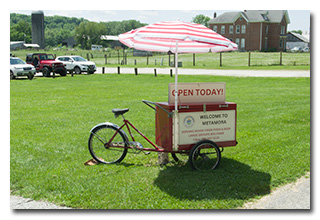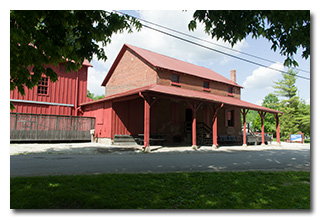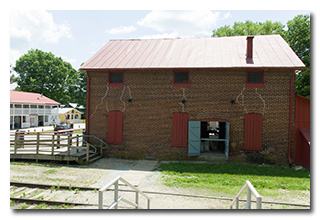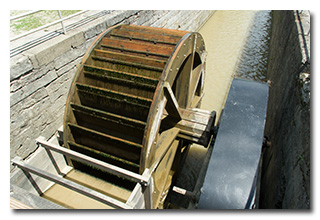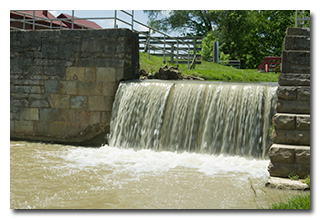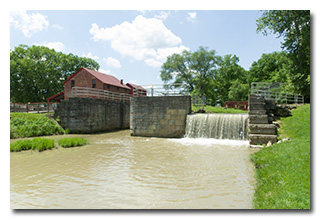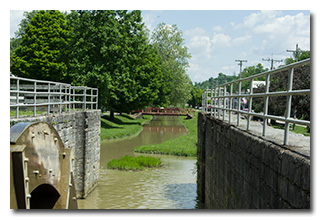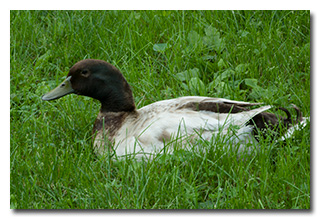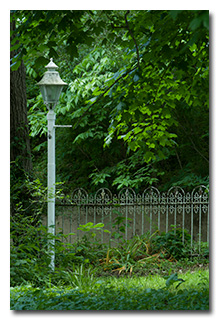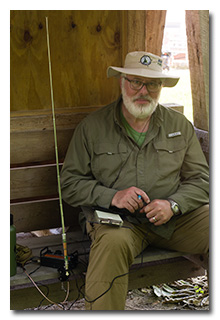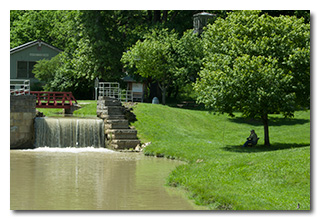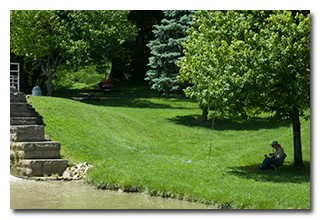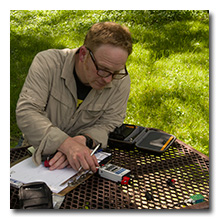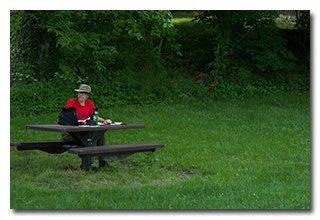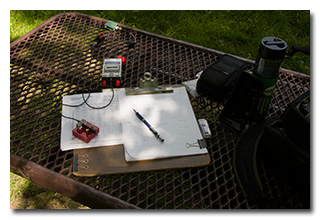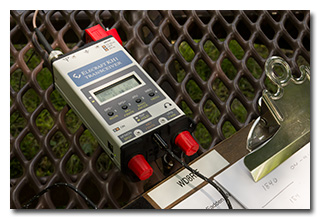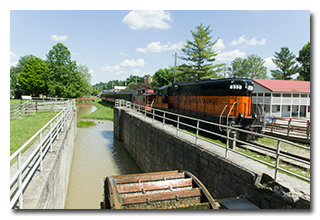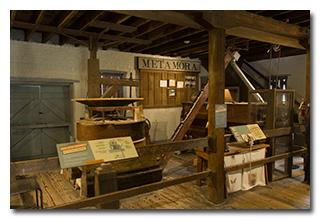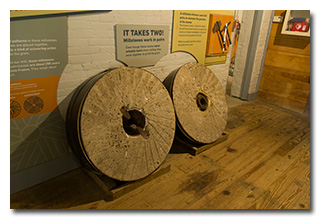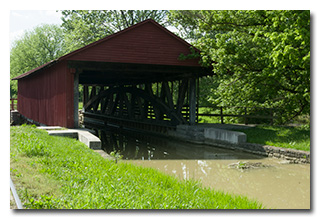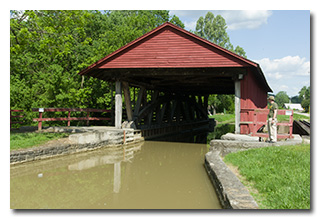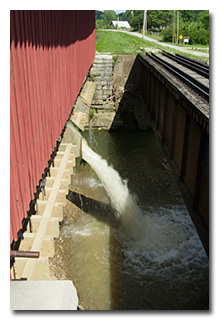
by William Eric McFadden
From the state historic site's website:
-
Metamora is an example of the kind of towns that grew along the canal routes in Indiana. Stationed every few miles, these towns provided a source of fresh horses, food and lodging for travelers and a place for farmers and others to buy and sell their goods along the canal route. Commerce was so heavy that the White Water Valley Canal Company, established in 1842, had their own bank and printed their own currency at their headquarters in Connersville!
Pictures
- "Welcome to Metamora"
- The Metamora Grist Mill: street-side | canal-side
- The mill's water-wheel in the lock
- The lock's overflow
- The mill and the lock
- A "boat's eye" view through the lock; photo by Miles McFadden
- A duck; photo by Miles McFadden
- A lamp post; photo by Miles McFadden
- Eric operating; photo by Miles McFadden
- Thomas operating: 1 | 2 | 3; photos by Miles McFadden
- Brian operating; photo by Miles McFadden
- The Whitewater Valley Rail Road
- Eric's KH1 station: 1 | 2
- Inside the Metamora Grist Mill: 1 | 2
- The Duck Creek Aquaduct: 1 | 2 | 3
Description
On Sunday, May 19, 2024, three members of the Southeast Ohio Radio Adventure Team performed successful activations of Whitewater Canal State Historic Site in Indiana as part of the Parks on the Air (POTA; link) program.
After spending Thursday, Friday, and Saturday at Hamvention (link) and Four Days in May (link), and following an activation with a larger group at Pater Wildlife Area (link), Eric McFadden, WD8RIF; Thomas Witherspoon, K4SWL; and Miles McFadden, KD8KNC, were joined by Brian Manley, K3ES, in Metamora for activations of Whitewater Canal State Historic Park. This would be the first time Thomas or Brian had performed activations in the state of Indiana. The weather was beautiful but HF propagation conditions were abysmal.
Thomas, Miles, Brian, and Eric arrived at Matamora just in time for lunch of wood-fired pizza at Third Place Metamora Pizza.
Following the excellent lunch, the group explored Metamora, keeping their eyes open for possible operating locations.
The group found that the grassy park area across the canal from the Metamora Grist Mill would be ideal for low-profile operations. Each operator chose a location within the grassy park suitable for their equipment and their style of operation. Brian, Eric, and Thomas were each on the air within a few minutes of 1840 UTC. Miles did not operate but helped with set-up and tear-down and did much of the activation photography. The site provided good cell-signal, meaning each operator would be able to spot himself on POTA Spots (link) and to use POTA Spots to identify possible park-to-park (P2P) QSO opportunities.
Brian chose the shaded bench behind an informational kiosk and deployed his Elecraft KX2 transceiver and AX1 antenna system.
Thomas chose a spot under a shade tree and deployed his Elecraft KX2 transceiver and JNCRadio MC-750 vertical antenna. Read Thomas's full report: From Hamvention to History: A POTA Excursion with Friends Through Indiana's Past.
Eric chose a picnic table under a large shade tree and deployed his Elecraft KH1 transceiver and an ad hoc end-fed random wire antenna.
This was to be Eric's second activation using his KH1 transceiver, his first being the activation a few hours earlier at Pater Wildlife Area in Ohio. For this operation, Eric chose to test an ad hoc end-fed random wire antenna consisting of the 33' wire from the Elecraft AXE1 40m Antenna Extender folded back to a length of 29' and supported as a sloper up to a Goture Red Fox Super Hard 720 carbon-fiber mast, fed through a binding-post adapter and operating against the KH1's 13' wire lying on the ground as a counterpoise. Eric had hoped that this wire would tune easily on all the bands the KH1 covers and this did prove to be the case. As at Pater Wildlife Area, Eric operated his KH1 in "tabletop" mode and used his Whiterook MK-33 paddle (link) instead of the KHPD1 paddle.
Eric began his operation by finding a clear frequency on 17m and calling "CQ POTA", and he was pleased to be auto-spotted on POTA Spots. The fact that the Reverse Beacon had heard Eric gave him hope that the bands were in better shape than they had been earlier in the day, but this hope was dashed when over ten minutes of calling CQ failed to produce even a single QSO.
Pausing to hunt for P2P QSOs, at 1853 UTC Eric barely managed to complete a P2P QSO on 20m with KC3FQF who was activating Fox Point State Park (US-1738) in Delaware. Returning to 17m to run a frequency for ten minutes failed to produce any additional QSOs.
At 1902 UTC, Eric swapped his antenna for a dummy load and completed a P2P QSO on 20m with Thomas who was set up less than 200' away. At 1906 UTC, using the same dummy load as an antenna, Eric completed P2P QSOs on 15 and 17m with Brian who was set up less than 100' away.
Reconnecting his antenna and switching to 30m, Eric found a frequency to run and called CQ for ten minutes with no responses.
At 1919 UTC, Eric again swapped his antenna for a dummy load and completed a P2P QSO on 30m with Thomas.
Finding himself a clear frequency on 20m to run, Eric began calling "CQ", and self-spotted himself on POTA Spots. The 20m band proved to be more productive than the other bands had, with Eric making five QSOs in thirteen minutes. Eric's first QSO in this run came at 1922 UTC with KX0R who was operating from a SOTA summit. This was followed by QSOs with N1BSA in Connecticut, K9IS in Wisconsin, KD5RXP in Nebraska, and K5DEZ in New Mexico.
Eric finished his activation by swapping his antenna for a dummy load and completing P2P QSOs on 40 and 20m with Brian at 1938 UTC and 1941 UTC.
In all, Eric made thirteen QSOs, with eight P2P QSOs, only one of which was not Whitewater Canal State Historic Site. All of Eric's QSOs were CW and were made with five watts output.
When each operator had validated his activation and all the stations were torn down, the group watched the arrival of the Whitewater Valley Rail Road (link) train from Connersville, Indiana, and toured the museum inside the Metamora Grist Mill. The museum was fascinating and the docent really knew her stuff and presented it well. Both Thomas and Eric bought packages of grits ground earlier that day in the grist mill.
On the drive out of Metamora, the group stopped at the Duck Creek Aquaduct (info), the last surviving wooden aquaduct in the United States.
(return)
